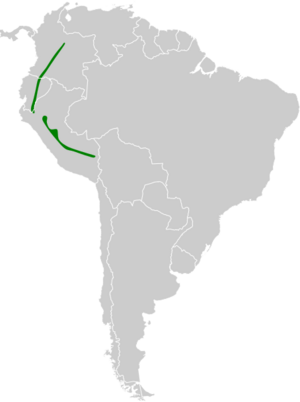Black-billed treehunter facts for kids
Quick facts for kids Black-billed treehunter |
|
|---|---|
 |
|
| Conservation status | |
| Scientific classification | |
| Genus: |
Thripadectes
|
| Species: |
melanorhynchus
|
 |
|
The black-billed treehunter (Thripadectes melanorhynchus) is a type of bird. It belongs to the ovenbird family called Furnariidae. You can find this bird in Colombia, Ecuador, and Peru.
Contents
About the Black-billed Treehunter
The black-billed treehunter has two main types, called subspecies. These are T. m. melanorhynchus and T. m. striaticeps. These two types are very similar to each other.
What Does the Black-billed Treehunter Look Like?
This bird is about 20 to 20.5 cm (7.9 to 8.1 in) long. That's about the length of a small ruler. It weighs around 39 to 46 g (1.4 to 1.6 oz), which is like a few pieces of candy.
It's a strong, dark bird with a shape like a thrush. Both male and female birds look the same. Their face is mostly blackish-brown with light streaks. The top of their head is also blackish-brown with thin streaks.
Their back is dark brown with light streaks. Their wings are a rich dark brown, and their tail is a dark reddish-brown. Their throat is a yellowish-brown color. Their chest is reddish-brown with faint light streaks. The rest of their belly is a plain dull reddish-brown.
Their eyes are brown. Their bill (beak) is black, and their legs and feet are dark grayish-black to brown. Young birds have less clear streaks on their back and throat. One subspecies, T. m. striaticeps, has a lighter head and back. It also has wider streaks and more reddish wings.
Where Does the Black-billed Treehunter Live?
The black-billed treehunter lives in South America. The main subspecies, T. m. melanorhynchus, lives on the eastern side of the Andes mountains. This area stretches from northern Ecuador all the way through Peru.
The other subspecies, T. m. striaticeps, lives on the eastern side of Colombia's Eastern Andes. This area goes from Boyacá and Casanare departments south into northern Ecuador.
These birds mostly live in mountain evergreen forests. They can also be found in secondary forests, which are forests that have grown back after being cut down. They like stunted forests along mountain ridges too. They usually live at heights between 1,000 and 1,800 m (3,300 and 5,900 ft) above sea level.
Black-billed Treehunter Behavior
How Does It Move?
The black-billed treehunter stays in its home area all year round. It does not migrate to other places.
What Does It Eat?
This bird mainly eats arthropods, which are creatures like insects and spiders. It might also eat small vertebrates, which are animals with backbones. It usually looks for food by itself in thick bushes and plants. It rarely joins groups of different bird species that are feeding together. It picks its prey from surfaces, but we don't know all the places it finds food.
How Does It Breed?
We don't know exactly when the black-billed treehunter's breeding season is. However, it seems to be from October to April. These birds are thought to stay with one partner for life.
They dig a tunnel up to 1 m (3.5 ft) long in an earthen bank. At the end of the tunnel, they make a chamber. They line this chamber with leaf stems and sometimes thin sticks. Only one nest has been found with three eggs. We don't know how long the eggs take to hatch or when the young birds leave the nest. Both parents help feed the baby birds.
What Does Its Song Sound Like?
The black-billed treehunter's song is a series of sharp "kyip" notes. The song starts fast, then slows down, and goes slightly lower in pitch. It has a "laughing" sound. Sometimes the notes are sung in pairs.
Conservation Status
The IUCN (International Union for Conservation of Nature) has listed the black-billed treehunter as a species of "Least Concern." This means it is not currently in danger of disappearing. It lives in a large area, and even though we don't know its exact population size, it seems to be stable. There are no immediate threats to this bird. It is considered uncommon in some places and fairly common in others. It also lives in several protected areas.


